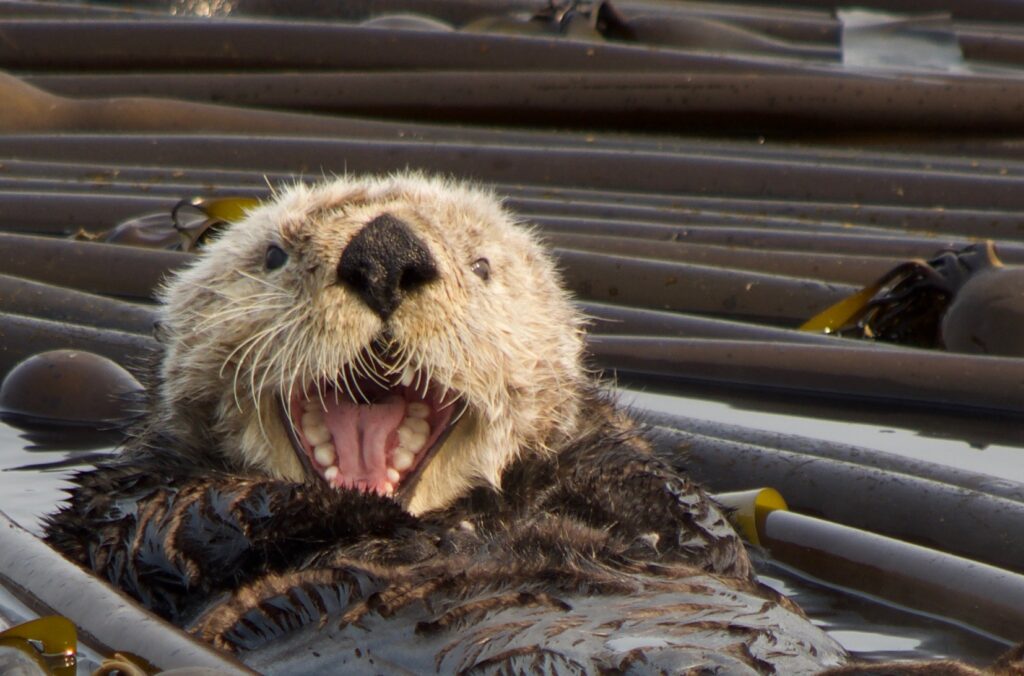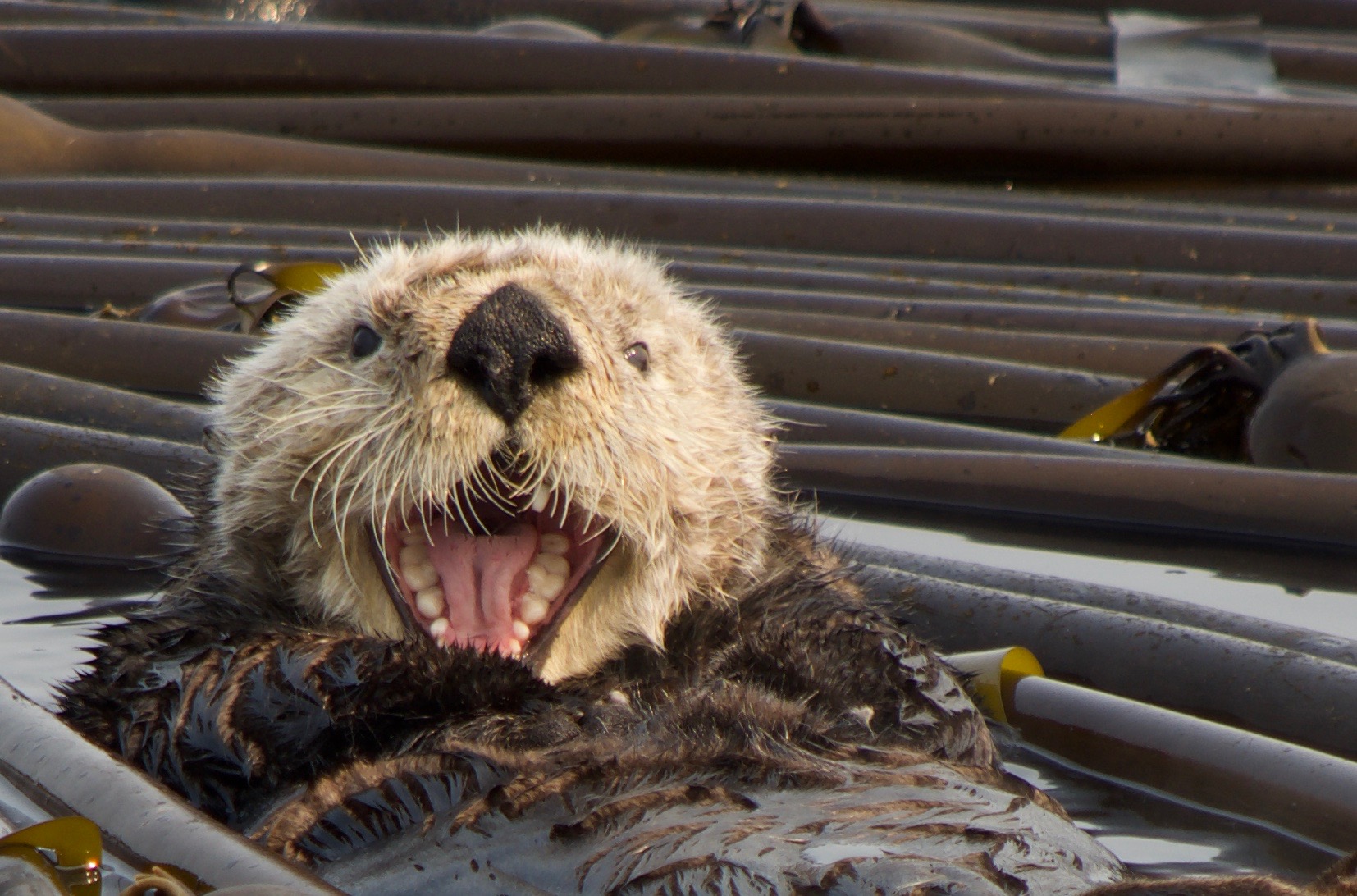While it is not hard for these little cuties to be the center of attention, based solely off their plushie-like appearance, these critters are the superstar to Sea Otter Awareness Week! Why do sea otters get a whole week to themselves? Let us take a step back in time to find out…

The Other “Gold” Rush
Back in the 18th and 19th century a booming trade struck gold off the west coast of British Columbia. In this case, “gold” references the much sought after, incredibly valuable, and all-around amazing pelts of the sea otter. With roughly one million hairs per square inch, sea otters take first place in the densest fur on earth. They have more hair in one square inch of their body then a human has on their whole head! Sea otter’s do not have a blubber layer, like most marine mammals, and need to constantly groom, maintain, and aerate their fur. The ritual of grooming traps air in between the hair follicles and creates an insulating layer which, not only keeps them warm, but allows them to be buoyant! One can see them blowing into their fur and fluffing it around with their paws – an activity that can take up to 15% of their day. Such dense fur requires a lot of maintenance which was part of what made pelts so precious – not only was it thick and fashionable but it does not shed or moult.
West coast indigenous communities recognized settlers sought such goods, subsequently using pelts as a primary export during the maritime fur trade. Furs as a form of currency, supplemented later with salmon, lumber, and art, brought other goods to the indigenous communities such as metal tools, guns, and even societal and political change from traditional values. The breadth of influence surrounding fur trade, let alone sea otter pelt, is far spread and we feel the impacts of those decisions to this day. Hunted to near extinction in the 19th century, only small pockets of sea otter populations survived in Alaska and California. Not only did this change the focus of human industry from fur to textiles, but the affects on the ecosystem were immensely damaging.
Holding it Together
Sea otters are remarkable predators and, with greater research, have been deemed a “keystone species”. Not only does this make them an incredibly cute poster child for the ecology movement but the way they interact with their environment is vital to the health of the ecosystem. They are an essential link in a chain of reactions and interactions. An activity many associate with sea otters is the act of drifting on their back, amidst the kelp, cracking urchins and shells on their belly. In an almost human like capacity, these animals use tools to help them break into their meals – often storing a favoured rock in a convenient pouch of skin near their armpit. This hints at a high cognitive ability as it requires planning ahead and problem solving, all linked with advanced structures in the brain!
However, the preferred diet of sea urchins is the most important link. In areas where populations of otters had been wiped out, sea urchins ran amuck. An element of an urchin’s diet consists of kelp and, without any predators to cull their numbers, sea urchins levelled aquatic forests. Now, kelp forests are just as important as terrestrial ones – they provide food and shelter to their inhabitants as well as acting like filters for carbon dioxide. During the photosynthesis process, kelp can reduce the amount of atmospheric carbon by a significant amount, therefore, not only improving the health of the immediate surrounding area but also the whole planet. Healthy, otter-maintained kelp forests are a key component to overall ocean wellbeing – reduced carbon means reduced acidity in the water which promotes a fully functioning ecosystem. Neat, huh? As we can see, the influence of dramatically altering one element of an ecological community has ripple effects that project further into the future than anyone could have predicted.
Reparations
In 1911, the very first international treaty with a focus on wildlife conservation, was signed by world powers that had profited off the pelts of sea otters and fur seals. The North Pacific Fur Seal Convention was a milestone in banning open water hunting and gave the US jurisdiction of commercial operations. This was step one to reducing the affect of devastated otter populations. Even though hunting otters is no longer legal, except for small harvests by indigenous groups, sea otters are still listed as an endangered species. Canada has also recently reassessed them as a ‘special concern’ as they have only re-populated about 25% of their former numbers with just over 3000 individuals along the west coast of British Columbia.
While hunting may not be as much of a threat any more, thanks to increased law enforcement, much larger human activity is still reducing the species’ ability to recover entirely. Oil spills are incredibly damaging to the ecosystem and otters are affected greatly. In an effort to clean themselves they end up ingesting the toxic substance. Not only that but the oil coats their thick fur so badly they are unable to fluff air in between the follicles causing them to die of hypothermia. While they are particularly susceptible to oil spills, other environmental factors are being identified such as commercial fishing net entanglement, toxins from human garbage, and disease from domesticated pets gone wild. In the northern coast of Alaska, the Aleutian Islands has seen the otter population decline from roughly 60 000 individuals (circa 1980) to about 6 000 (circa 2000) due to supposed increased predation from an apex predator we are all familiar with. Orcas. While hard evidence is yet to be found, we can assume humans have played another role in the changing natural world. Commercial whaling in the 60’s likely reduced the biomass of available food for orcas who later adapted to sourcing smaller mammals like sea otters.
The circle of life is neither simple nor linear. Instead, it is a web of intertwined and entangled pathways. Humans have plucked at threads for years causing entire sections of the network to crumble in ways we never would have predicted. In this industry, we have the privilege of educating many people about our local ecology and the affects we have. By viewing animals in their natural habitat this provides an excellent opportunity to continue and promote protections and regulations that benefit our local flora and fauna. Its easier to protect something you feel connected to and, come on, who wouldn’t want to have a moment with these guys? With their chubby cheeks, ecological niche, and abundant charisma, sea otters are the perfect animal to dedicate a whole week to. Happy Sea Otter Awareness Week – may we continue to do and be better.
—————–
Morgan Uhlmann
Crew Member at SpringTide Whale Watching & Eco Tours
